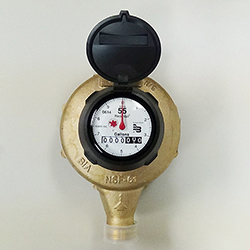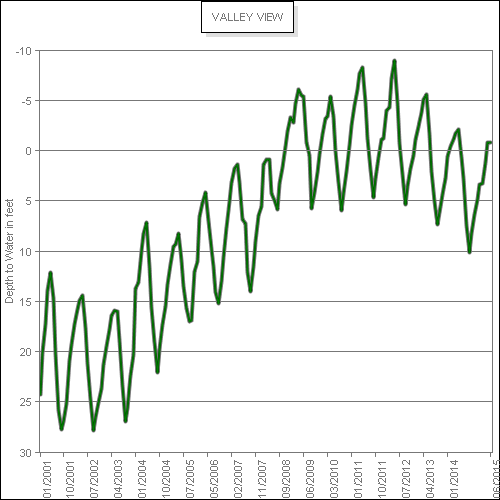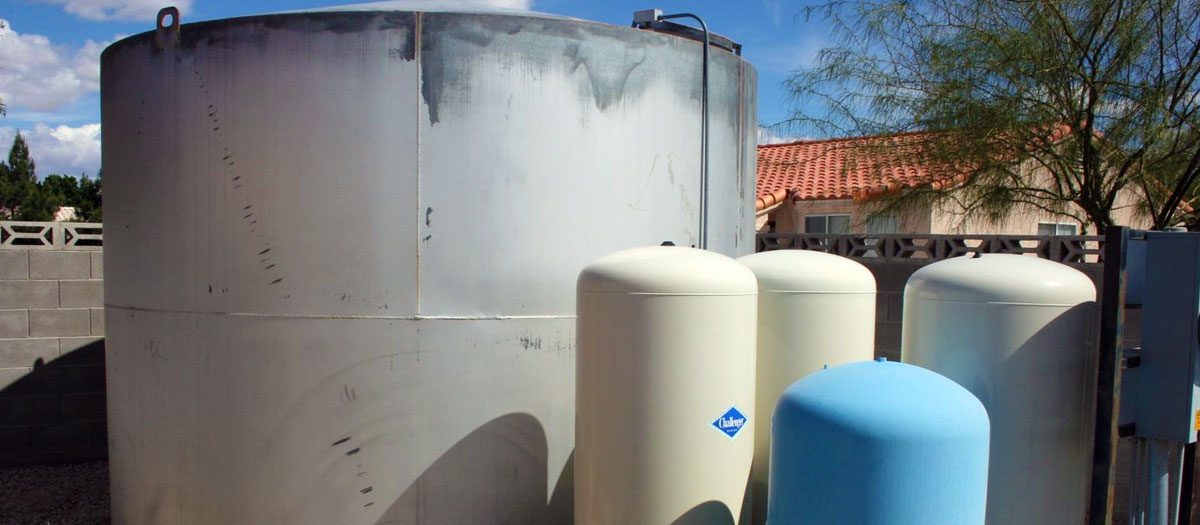Know your well
The Office of the State Engineer was created in 1903 to protect existing water rights and to improve methods for using Nevada's valuable water resources. The State Engineer is responsible for administering and enforcing Nevada water law, which includes the appropriation and adjudication of groundwater in the state.
Important facts for well users
- The permitted use of water from a quasi-municipal well (a well serving two or more homes) is based on an average of 1,000 gallons per day per home, not to exceed 365,000 gallons per year per home. Such wells also are known as public supply wells or community wells.
- Use of water from a domestic well (a well serving a single home) shall not exceed 1,800 gallons per day.
- All quasi-municipal wells are required to have a meter, and accurate readings must be kept of all water pumped from the well.
- A domestic well is one that serves a single home without a water right permit. Domestic well water usage may not exceed 1,800 gallons per day
- Nevada Revised Statute (NRS) 534.130 grants water-resource agencies access to private property to carry out their duties during reasonable hours of the day.
- Under NRS 197.090, any person whom by means of any threat, force or violence, attempts to prevent an administrative officer from performing a duty imposed on him by law is guilty of a gross misdemeanor.
Frequently asked questions
Tips for safety, health and water conservation
Establish a wellhead protection area around your well with a minimum radius of 100 feet. Do not spill, store or dispose of animal wastes, fuels, pesticides, fertilizers or paints within that area.
The Southern Nevada Health District offers free water quality tests to detect lead, arsenic, bacteria, and other harmful materials in your well water. Request a free test.
Check for broken water lines, which are one of the major causes of hidden leaks and wasted water from wells. Take extra care when searching for a broken line, due to the pressure and storage tanks installed as part of your well system.
Well protection
Doing your part to protect our groundwater supply
If you’re a well user, you play an important role as a water steward in Southern Nevada. You can help protect the groundwater supply by becoming knowledgeable about how your well works, taking steps to protect your well from contamination and checking the quality of your well water periodically.
Follow these guidelines to prevent groundwater contamination:
- Don’t pour hazardous materials down the drain.
- Don’t put hazardous materials in the trash.
- Don’t dump hazardous materials on the ground.
- Dispose of harmful materials properly.
- Take care of your septic system.
Ensure proper well abandonment
Abandoned wells can represent a significant risk to groundwater quality. If a well is abandoned without being properly sealed, it can act as a direct channel for contaminants to reach groundwater.
To properly abandon a well, a licensed well driller must:
- Remove the pump/column from the well.
- Clean any debris out of the well.
- Perforate the casing to 50 feet above the static water level.
- Plug the well with cement/grout from the bottom of the well to the surface.
If you are aware of any abandoned wells, please report the abandoned well so that it can be investigated.
Protect your wellhead with these tips:
- Don’t spill, store or dispose of animal wastes, fuels, pesticides, fertilizers, paints and other harmful products within a wellhead protection area or within the wellhead protection area of adjacent properties.
- Test your well water at least once each year if you are a private well owner for coliform bacteria and at least once every three years for the Routine Domestic Water Analysis. For more information, call a certified private lab. These organizations may be helpful:
- The Southern Nevada Health District can provide a list of State of Nevada Certified Laboratories. The Health District also will provide an interpretation of your lab results upon request.
- The University of Nevada, Reno Water Data Interpreter will assess your lab results.
- Develop wells only outside areas of potential contamination. A well should not be located near corrals, pastures, feed lots or drainage ways of underground fuel storage tanks.
- Establish a wellhead protection area. The area should be a circle around the well that has a minimum radius of 100 feet from the wellhead.
Well maintenance
Any well serving two or more homes is required to have a meter installed and maintained near the discharge pipeline near the point of diversion. The well users must maintain the meter and keep accurate readings of the water use:
How to read your water meter
- Locate your well meter.
- If necessary, remove the meter box lid with a screwdriver or appropriate tool.
- Lift the cap covering the meter lens and face the meter so that the "0" on the outer dial is at the top (see Figure 1).
- Locate the number bar on the face of the meter (see Figure 2). Write down the number as it appears from left to right. Note that the zero or zeroes on the far right do not move.
- After obtaining your reading, close the meter cap to prevent damage to the lens and replace the meter box lid if necessary.

Figure 1
![]()
Figure 2
Finding leaks
Not all leaks are as obvious as a dripping faucet. If you hear water running in your home when no water is in use or your water usage is suddenly higher than expected, you might have a water leak. If you have a metered well, the steps below can help to find out if there is a leak on your property and where it’s coming from.
Find out if you have a leak
Turn off all of your water fixtures and appliances (don’t forget the ice maker, water filtration system and other systems), then find your water meter.
Depending on the type of meter you have, you’ll see either a red flow indicator or a sweep hand. If the sweep hand or flow indicator is still moving after you’ve turned off all of the water in your home, you might have a leak.
Turn your water fixtures and appliances back on, but try not to use them until you know where the leak is coming from.
Learn more about finding and fixing leaks at SNWA.com.
Find the source
The next step is to find the source of the leak. Turn off fixtures and appliances one by one, checking the meter after you turn each one off. If the flow indicator or sweep hand is still moving when you check the meter, you haven't found the leak yet. Continue turning off fixtures and checking the meter until the meter stops—then you’ll know you’ve found the source. Items to turn off include:
- Toilets, which can be turned off at the base.
- Faucets, which can be turned off below the sink.
- Sprinkler systems, water softeners, swamp coolers, ice machines and reverse osmosis units, all of which have a bypass valve that lets water bypass the unit.
Check the main service line
If you still haven't found the problem, try checking the main service line. Find the water shutoff valve to your home. It will be either in your front yard, in your garage, or near your water softener. Shut off this valve, turning off all water to your home. Turn on a faucet to make sure there is no water, then check the meter. If the meter is still moving, the leak is most likely between the shutoff valve and the water meter.
If you've found your leak, you may be able to fix it yourself. Repairs to toilets and faucets can be fairly simple, while other leaks may need a professional plumber. Don't get in over your head. If you're not sure you can fix it, call a professional.
Check out the water efficiency of your fixtures by requesting a free Water Audit Kit from the Southern Nevada Water Authority.
Hydrologic Monitoring Network
The Las Vegas Valley Groundwater Management Program Hydrologic Monitoring Network (GMP-HMN) was established to help inform well owners about hydrologic conditions in the valley and to provide well owners an opportunity to observe fluctuations in water levels at monitoring locations near their wells.
The GMP-HMN is composed of 16 wells completed in both the principal aquifer and shallow groundwater system at locations shown on the map. These wells augment other extensive water-level monitoring networks in the valley which are measured by different agencies for the purposes of monitoring hydrologic conditions and managing groundwater quality and water resources.
Monitoring networks are established and maintained to observe water level changes in the groundwater system over time to help understand the hydrologic properties and conditions in a given aquifer. The changes that are observed may be natural variations such as changes in precipitation or may be caused by human activities such as pumping or groundwater recharge programs. Once a monitoring site has enough data to establish a historical record, long-term water level trends and ranges can be projected.
The wells within the network include dedicated monitor wells, unused or inactive water wells, and active production and recharge wells. The physical construction specifications including the location, depth, and screened interval of the well determines the portion of the aquifer system being monitored.
The wells are monitored by physically measuring the water level using an electronic tape which indicates depth to water to within 0.01 feet. Many wells are also equipped with a pressure transducer which is a sensor that measures changes in water levels continuously on an hourly basis. The data from the transducer is stored in a data logger which is then downloaded on a regular basis by hydrologists. The data from the GMP-HMN wells are uploaded to the web site quarterly.
The water levels within the principal aquifer are active with short term, seasonal, annual, and decade-long variations observed. Hourly and daily data can record variations in barometric pressure. This type of data is usually measured with units less than a foot. Water level variation from cyclic daily and seasonal production of nearby water wells can be observed from less than a foot to tens of feet. Increased long-term water levels from the artificial recharge program first implemented in 1989 can also be observed. Other unique events such as quick small water level changes associated with earthquakes can also be observed.
Water level data are plotted as depth to water on the vertical axis against time on the horizontal axis. The plots are referred to as hydrographs. Positive values for depth indicate water level below land surface. Negative values for depth indicate water level above ground surface or flowing (if well cap was open) artesian conditions. Water levels can also be presented as elevation to determine groundwater flow direction between similar constructed wells.

